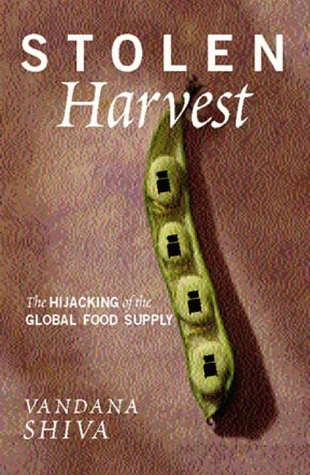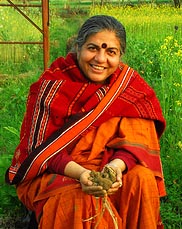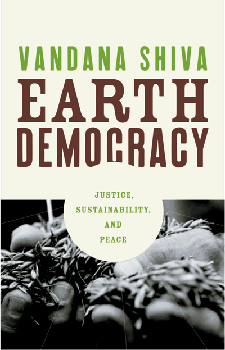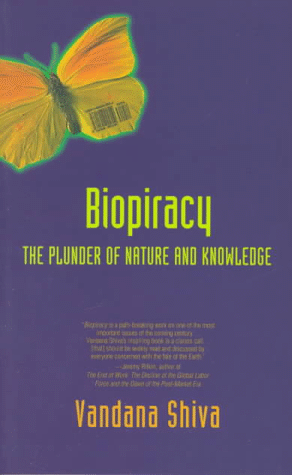 |
Home |
Catalogs |
Contact Us |

Books on:
Animal RightsBlack History
Clean Energy
Democracy
Eco Design
Eco History
Food and Nutrition
Genetic Engineering
Green Cities
Green Politics
Local Economics
Natural Building
Peace and Nonviolence
Simple Living
Trees and Forests
 |
Stolen Harvest
The Hijacking of the Global Food Supply
by Vandana Shiva
South End Press, 1999, 148 pages, paperback
Purchase
on Amazon.com
In Stolen Harvest, Vandana Shiva describes how industrial agriculture steals food from nature and poor people. She urges us to reclaim our right to protect the earth and her diverse species. Food democracy, she says, is the new agenda for ecological sustainability and social justice.
Quotes from Stolen Harvest
Over the past two decades every issue I have been engaged in as an ecological activist and organic intellectual has revealed that what the industrial economy calls "growth" is really a form of theft from nature and people.
It is true that cutting down forests or converting natural forests into monocultures of pine and eucalyptus for industrial raw material generates revenues and growth. But this growth is based on robbing the forest of its biodiversity and its capacity to conserve soil and water. This growth is based on robbing forest communities of their sources of food, fodder, fuel, fiber, medicine, and security from floods and drought.
While most environmentalists can recognize that converting a natural forest into a monoculture is an impoverishment, many do not extend this insight to industrial agriculture. A corporate myth has been created, shared by most mainstream environmentalists and development organizations, that industrial agriculture is necessary to grow more food and reduce hunger. Many also assume that intensive, industrial agriculture saves resources and, therefore, saves species. But in agriculture as much as in forestry, the growth illusion hides theft from nature and the poor, masking the creation of scarcity as growth.
These thefts have only stepped up since the advent of the globalized economy. The completion of the Uruguay Round of the General Agreement on Tariffs and TRade (GATT) in 1994 and the establishment of the World Trade Organization (WTO) have institutionalized and legalized corporate growth based on harvests stolen from nature and people. The WTO's Trade Related Intellectual Property Rights criminalizes seed-saving and seed-sharing. The Agreement on Agriculture legalizes the dumping of genetically engineered foods on countries and criminalizes actions to protect the biological and cultural diversity on which diverse food systems are based.
...
I focus on India to tell the story of how corporate control of food and globalization of agriculture are robbing millions of their livelihoods and their right to food both because I am an Indian and because Indian agriculture is being especially targeted by global corporations. Since 75 percent of the Indian population derives its livelihood from agriculture, and every fourth farmer in the world is an Indian, the impact of globalization on Indian agriculture agriculture is of global significance.
However, this phenomenon of the stolen harvest is not unique to India. It is being experienced in every society, as small farms and small farmers are pushed to extinction, as monocultures replace biodiverse crops, as farming is transformed from the production of nourishing and diverse foods into the creation of markets for genetically engineered seeds, herbicides, and pesticides. As farmers are transformed from producers into consumers of coporate-patented agricultural products, as markets are destoryed locally and nationally but expanded globally, the myth of "free trade" and the global economy becomes a means for the rich to rob the poor of their right to food and even their right to life. For the vast majority of the world's people--70 percent--earn their livelihoods by producing food. The majority of these farmers are women. In contrast, in the industrialized countries, only 2 percent of the population are farmers.
...
Industrial agriculture has not produced more food. It has destroyed diverse sources of food, and it has stolen food from other species to bring larger quantities of specific commodities to the market using huge quantities of fossil fuels and water and toxic chemicals in the process.
It is often said that the so-called miracle varieties of the Green Revolution in modern industrial agriculture prevented famine becuse they had higher yields. However, these higher yields disappear in the context of total yields of crops on farms. Green Revolution varieties produced more grain by diverting production away from straw. This "partitioning" was achieved through dwarfing the plants, which also enabled them to withstand high doses of chemical fertilizer.
However, less straw means less fodder for cattle and less organic matter for the soil to feed the millions of soil organisms that make and rejuvenate soil. The higher yields of wheat or maize were thus achieved by stealing food from farm animals and soil organisms. Since cattle and earthworms are our partners in food production, stealing food from them makes it impossible to maintain food production over time, and means that the partial yield increases were not sustainable.
The increase in yields of wheat and maize under industrial agriculture were also achieved at the cost of yields of other foods a small farm provides. Beans, legumes, fruits, and vegetables all disappeared both from farms and from the calculus of yields. More grain from two or three commodities arrived on national and international markets, but less food was eaten by farm families in the Third World.
The gain in "yields" of industrially produced crops is thus based on a theft of food from other species and the rural poor in the Third World. That is why, as more grain is produced and traded globally, more people go hungry in the Third World. Global markets have more commodities for trading because food has been robbed from nature and the poor. . . .
A study comparing traditional polycultures with industrial monocultures shows that a polyculture system can produce 100 units of food from 5 units of inputs, whereas an industiral system requires 300 units of input to produce the same 100 units. The 295 units of wasted inputs could have provided 5,900 units of additional food. Thus the industrial system leads to a decline of 5,900 units of food. This is a recipe for starving people, not for feeding them.
...
Indigenous oilseeds, being high in oil content, are easy to process at small-scale, decentralized levels with eco-friendly and health-friendly technologies … The bulk of oilseed processing is done by over 1 million ghanis (expellers) and 20,000 small and tiny crushers that account for 68 percent of edible oils processed … Women in the bastis, or slums, usually buy small quantities of mustard oil extracted on their local ghani in front of their eyes…Yet these community-based systems of food and health safety were quickly dismantled in the name of food safety in 1998, when local processing of mustard oil was banned and free imports of soybean oil were installed in response to a mysterious contamination of Delhi’s edible-oil supply.
...
The environmental destruction caused by intensive shrimp farming is one of the major factors for its spread in Third World countries, even though the main consumers of shrimp live in affluent countries. In country after country where commercial shrimp fishing has been tried, it has proven unsustainable. For this reason, this industry is known as a ‘rape and run’ industry.
...
Indigenous cattle do not compete with humans for food; rather, they provide organic fertilizer for fields and thus enhance food productivity. Within the sacredness of the cow lie this ecological rationale and conservation imperative. The cow is a source of cow-dung energy, nutrition, and leather, and its contribution is linked to the work of women in feeding and milking cows, collecting cow dung, and nurturing sick cows to health.
...
The right of corporations to force-feed citizens of the world with culturally inappropriate and hazardous foods has been made absolute [in the globalizing economy]. The right to food, the right to safety, the right to culture are all being treated as trade barriers that need to be dismantled…we have to reclaim our right to nutrition and food safety. We have to reclaim our right to protect the earth and her diverse species. We have to stop this corporate theft from the poor and from nature. Food democracy…is the new agenda for ecological sustainability and social justice.
...
The time has come to reclaim the stolen harvest and celebrate the growing and giving of good food as the highest gift and most revolutionary act.
Table of Contents of Stolen Harvest
Introduction
Piracy Through Patents: The Second Coming of Columbus
Chapter One
The Hijacking of the Global Food Supply
Chapter Two
Soy Imperialism and the Destruction of Local Food Cultures
Chapter Three
The Stolen Harvest Under the Sea
Chapter Four
Mad Cows and Sacred Cows
Chapter Five
The Stolen Harvest of Seed
Chapter Six
Genetic Engineering and Food Security
Chapter Seven
Reclaiming Food Democracy
Reader Comments |


